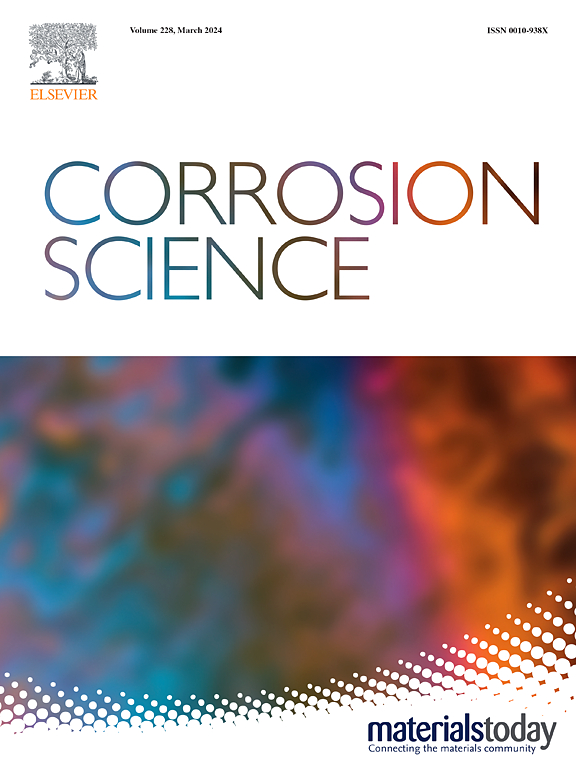多组分二硅酸盐(Ho0.2Er0.2Tm0.2Yb0.2Lu0.2)2Si2O7 对 CMAS 和火山灰的抗腐蚀性能
IF 7.4
1区 材料科学
Q1 MATERIALS SCIENCE, MULTIDISCIPLINARY
引用次数: 0
摘要
随着燃气涡轮发动机工作温度的不断升高,钙镁铝硅酸盐(CMAS)对应用于航空发动机热截面的环境屏障涂层(EBC)构成了严重威胁。在这里,我们合成了一种新型多组分二硅酸盐--(Ho0.2Er0.2Tm0.2Yb0.2Lu0.2)2Si2O7(简写为 (5RE0.2)2Si2O7),并比较研究了它在 1400ºC 下与合成 CMAS 和天然火山灰存在时的性能。与 Yb2Si2O7 相比,(5RE0.2)2Si2O7 的 Si-O 键长度较短,RE-O 键长度较大,因为平均 RE3+ 半径较大。CMAS 腐蚀后,一些磷灰石晶粒会在 CMAS/(5RE0.2)2Si2O7 界面析出,形成疏松的反应层,表现出比 Yb2Si2O7 更高的耐腐蚀性。同时,化学反应过程中 CaO 的消耗和 SiO2 的释放在一定程度上增加了 CMAS 的粘度,从而削弱了其浸润倾向。在火山灰的情况下,由于 CaO 含量相对较低,它直接沿着晶界渗入 (5RE0.2)2Si2O7 的内部而不发生任何反应,表现出更严重的侵蚀行为。此外,(5RE0.2)2Si2O7 因其较低的表面能而有效地增加了熔融火山灰的接触角。这些发现为下一代 EBC 材料的设计和应用提供了更好的理解。本文章由计算机程序翻译,如有差异,请以英文原文为准。
Corrosion resistance of multicomponent disilicate (Ho0.2Er0.2Tm0.2Yb0.2Lu0.2)2Si2O7 against CMAS and volcanic ash
With the increasing operating temperature of gas turbine engines, calcium-magnesium-aluminosilicate (CMAS) poses a serious threat on environmental barrier coatings (EBCs) applied on hot-sections of aero-engines. Here, we have synthesized a novel multicomponent disilicate—(Ho0.2Er0.2Tm0.2Yb0.2Lu0.2)2Si2O7 (brief to (5RE0.2)2Si2O7), and comparatively studied its performance in the presence of synthesized CMAS and natural volcanic ash at 1400ºC. In comparison with Yb2Si2O7, (5RE0.2)2Si2O7 has a shorter Si-O bond length and a larger RE-O bond length because of the larger average RE3+ radius. After CMAS corrosion, some apatite grains precipitate at the CMAS/(5RE0.2)2Si2O7 interface to develop a loose reaction layer, exhibiting a higher corrosion resistance than Yb2Si2O7. Meanwhile, the consumption of CaO and release of SiO2 during the chemical reaction process increase the viscosity of CMAS to some extent and thus weaken its infiltration propensity. For the volcanic ash case, it directly infiltrates into the interior of (5RE0.2)2Si2O7 along grain boundaries without any reaction due to the relatively low CaO content, exhibiting a more serious attacking behavior. In addition, (5RE0.2)2Si2O7 effectively increases the contact angle of molten volcanic ash due to its lower surface energy. These finds here provide a better understanding for the design and application of next-generation EBC material.
求助全文
通过发布文献求助,成功后即可免费获取论文全文。
去求助
来源期刊

Corrosion Science
工程技术-材料科学:综合
CiteScore
13.60
自引率
18.10%
发文量
763
审稿时长
46 days
期刊介绍:
Corrosion occurrence and its practical control encompass a vast array of scientific knowledge. Corrosion Science endeavors to serve as the conduit for the exchange of ideas, developments, and research across all facets of this field, encompassing both metallic and non-metallic corrosion. The scope of this international journal is broad and inclusive. Published papers span from highly theoretical inquiries to essentially practical applications, covering diverse areas such as high-temperature oxidation, passivity, anodic oxidation, biochemical corrosion, stress corrosion cracking, and corrosion control mechanisms and methodologies.
This journal publishes original papers and critical reviews across the spectrum of pure and applied corrosion, material degradation, and surface science and engineering. It serves as a crucial link connecting metallurgists, materials scientists, and researchers investigating corrosion and degradation phenomena. Join us in advancing knowledge and understanding in the vital field of corrosion science.
 求助内容:
求助内容: 应助结果提醒方式:
应助结果提醒方式:


